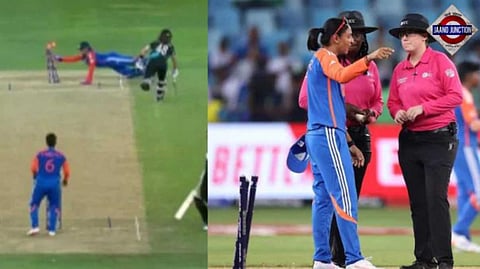

Harmanpreet Kaur was left fuming as Amelia Kerr survived a close run out when India and New Zealand locked horns in the group match of the Women’s T20 World Cup 2024 on Friday, October 4 at the Dubai International Cricket Stadium. In the last ball of the 14th over of the White Ferns’ innings, a strong throw from Harmanpreet caught Kerr short at the striker’s end.
The Indians celebrated and Kerr was also on the way back to the pavilion. But then, the umpires decided to call the batter back. Harmanpreet and Smriti Mandhana were not happy, having a heated discussion with the on-field umpires Jacqueline Williams and Anna Harris. Head coach Amol Mazumdar also had a discussion with the fourth umpire.
It started with Kerr initially taking a single down the ground off Deepti Sharma. When Harmanpreet had the ball in her hands at long-off, Kerr and New Zealand skipper Sophie Devine tried to pinch a second run. But Kerr responded late for the second run and could not make her way back. Richa Ghosh took the bails off at the striker’s end and erupted in joy.
When the players were celebrating the dismissal, the umpires asked Kerr to come back after deciding that the ball was already ‘dead’ when Richa affected the run out. Play was held up for quite some time before the fourth umpire asked for play to be continued.
Kerr was batting on 14 when the controversy happened. However, she failed to make use of the lifeline after Renuka Singh got her caught by Pooja Vastrakar at extra cover. Kerr scored 13 runs off 22 balls and also built a partnership of 32 runs with Devine for the third wicket.
Commentator WV Raman said that the umpires considered the ball dead when the umpire handed over the cap to Deepti at the end of the over.
What does the dead-ball rule say?
As per the MCC Laws
20.1.1 The ball becomes dead when
20.1.1.1 it is finally settled in the hands of the wicket-keeper or of the bowler.
20.1.1.2 a boundary is scored.
20.1.1.3 a batter is dismissed. The ball will be deemed to be dead from the instant of the incident causing the dismissal.
20.1.1.4 whether played or not it becomes trapped between the bat and person of a batter or between items of his/her clothing or equipment.
20.1.1.5 whether played or not it lodges in the clothing or equipment of a batter or the clothing of an umpire.
20.1.1.6 under either of Laws 24.4 (Player returning without permission) or 28.2 (Fielding the ball) there is an offence resulting in an award of Penalty runs. The ball shall not count as one of the over.
20.1.1.7 there is contravention of Law 28.3 (Protective helmets belonging to the fielding side).
20.1.1.8 the match is concluded in any of the ways stated in Law 12.9 (Conclusion of match).
20.1.2 The ball shall be considered to be dead when it is clear to the bowler’s end umpire that the fielding side and both batters at the wicket have ceased to regard it as in play.
20.2 Ball finally settled
Whether the ball is finally settled or not is a matter for the umpire alone to decide.
20.3 Call of Over or Time
Neither the call of Over, nor the call of Time is to be made until the ball is dead
